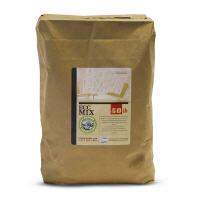ECC Blended Mix /22,7 kg
The most advanced mix design available is ECC (Engineered Cementitious Composite). This mix was originally developed for use in seismic zones for its high ductility. It has been modified to improve the mix characteristics while maintaining performance. The strength of our ECC recipes comes from the combination of particle gradation and the addition of a high dosage of fiber. From a creative standpoint, ECC can be mixed to unique workabilities, allowing for many variations in finish. While this mix takes some getting used to, the professionals that use it swear by its vast aesthetic and performance potential. It is very strong, it will bend before it breaks, and it produces unrivaled finishes and durability.
ECC uses all white ingredients, naturally curing to a bone white. The mix can be pigmented with any of the BR Color Series. The mix has all of the necessary high-performance ingredients preblended, including curing polymer, such that only water and necessary reinforcement need to be added. The workability of the mix can be changed with the addition of our series of water reducers.
COVERAGE AND CEMENT CONTENT
This mix is typically done at 1,9 cm, - 2,54 cm thick. This mix is often cast at 1 cm thick for objects like tiles, but considerations must be given in the handling and support of the piece.
Coverage: +/- 0,5 m2 at 2,5 cm thick.
Total Cementitious Binder (per 22,7 kg bag):12,7 kg
|
|
instructions
Preparation - Getting Ready to Mix
Have all ingredients assembled before you start. Wear vinyl or nitrile gloves and protective eye wear. Use an accurate scale for weighing components. Use materials between 10° C - 32° C. Colder temperatureswill slow the reaction and warmer temperatures will accelerate it.
The temperature of the ECC Blended Mix is also important and will affect the outcome. Once the temperature of the mix reaches 21° C, the reaction begins to accelerate. Using a laser thermometer to monitor, keep the temperature of the mix near 15° C. In warm environments, substitute up to 50% of the water weight with ice. ECC Blended Mix has a shelf life of 1 year after purchase if kept in a dry, moisture free environment. Once opened, the material should be used as soon as possible.
Mixing Instructions
Use clean, potable water and clean mixing vessels. Use a handheld mortar mixer to mix. If mixing on a regular basis or for a large project, investing in a vertical shaft mixer may be justified.
• Combine water and pigment together and mix thoroughly.
• Add 50% of the water reducer to the water. Slowly add dry ingredients while continuing to blend.
• Slowly add PVA Fibers to the mix. Blend until homogeneous
• Temper with water reducer as needed for desired consistency.
If Using Acrylic Fiber:
• Overdosing acrylic fibers can easily choke up a concrete mix. Some users find blending the fibers in the mix water first provides optimal dispersion. Others prefer to slowly blend the fibers into the concrete slurry later in the mixing process. Some experimentation is suggested to determine the best solution for a specific mix design.
Casting Techniques
Clay Technique - This is a stiff recipe, which can be pressed up vertical walls and into molds to create beautiful finishes. While it is quite a bit different to work with than the Craftsman Mix, you can achieve brilliant veined finishes with tremendous durability. Color contrasting veining is possible with the addition of 0.5% PVA 15 and 0.2% AC 50 fibers. The mix will hold together, keeping different pigments loaded in separate batches from bleeding together into a new color. Patience is key when mixing this recipe. Adding the fibers too quickly can choke the mix
Cast Technique - This recipe has a soft consistency that is not as fluid as the Flowable mix, but easier to move around than the Clay mix. It is ideal for casting and troweling. This mix uses a combination of 1% PVA 100 and 0.5% PVA 15 to create an "oatmeallike" full-body consistency. It is best used in simple 2 dimensional shaped forms, such as countertops. Many interesting effects can be created using this recipe in different ways during casting. It is often used in combination with the Clay mix.
Flowable Technique - This recipe produces a fluid ECC mix. It can be placed directly into forms, and will consolidate with minimal effort. Use up to 1.5% PVA 100 fibers only for a fluid and strong mix that will fill into almost any mold with intricate detail.
Curing
In order to ensure that concrete reaches its maximum potential, keep the concrete warm and moist while curing. Ambient temperature should be kept at a minimum of 10°C. A layer of moist felt or fabric followed by plastic
sheeting will keep the moisture from escaping. This is often covered again by blankets or insulation to keep the heat from leaving the matrix. This is specially important on troweled finishes, since plastic placed directly on them is likely to leave discolorations. Demold after 24-48 hours, depending on shop conditions.
Polishing
Polishing can be done wet or dry. We recommend wet polishing as it will provide a finish true to the grit used and it reduces the risk to your health. To maintain the cream layer, lightly polish the concrete using pads that are 200 grit or higher. The higher grits produce higher sheen. To expose your sand (salt and pepper look) or any decorative aggregate, begin grinding with coarser grit pads, progressing to finer grits until reaching the desired sheen and aggregate exposure.
Sealing
Concrete is an inherently porous material and needs to be sealed for particular environments and uses. Choose the sealer that best fits the needs of the finishedpiece and the skill level of the person applying it. Buddy Rhodes offers a variety of sealer options, which can be found on our website.
